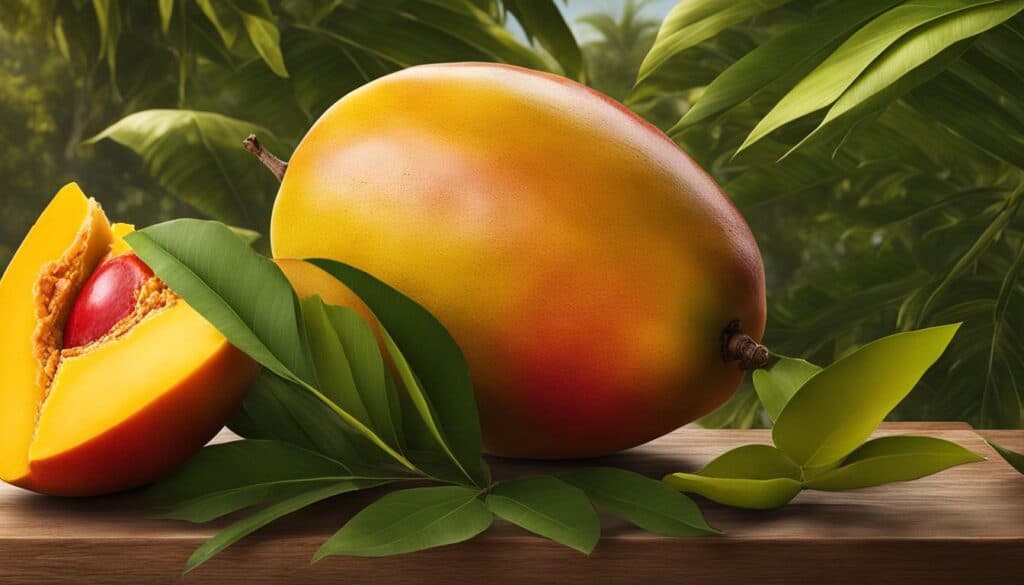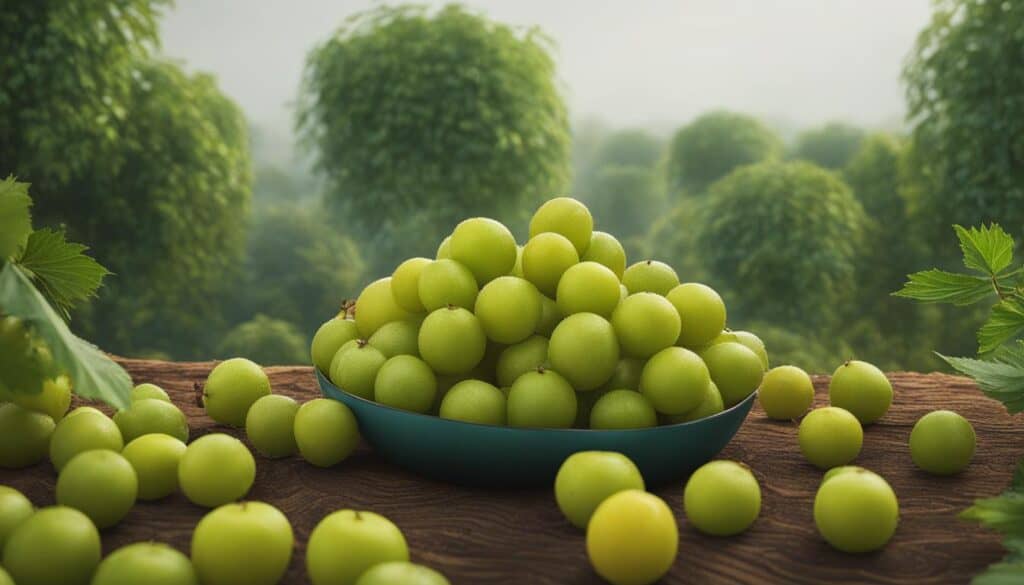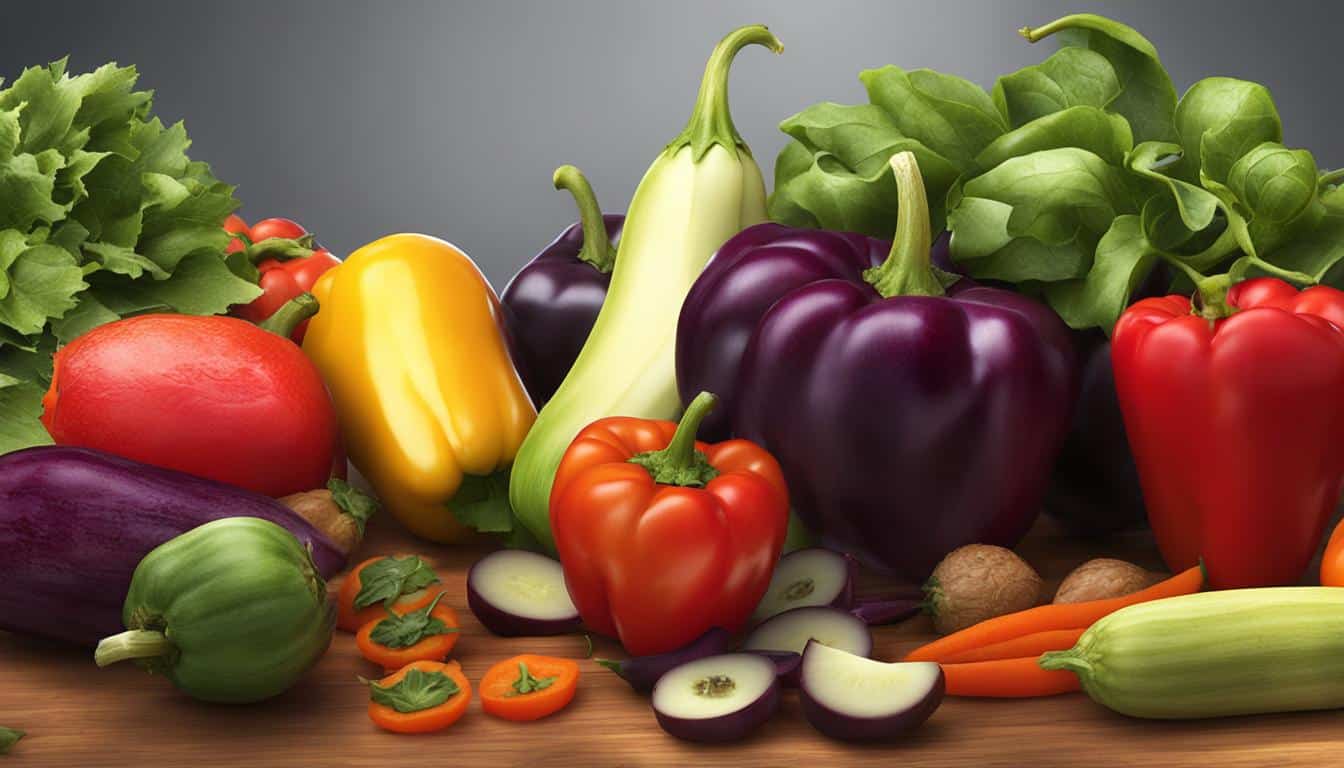Are you curious about fruits and vegetables that start with the letter I? Look no further! We have compiled an alphabetical list of healthy produce items that will tantalize your taste buds and add variety to your diet.
From Indian fig fruit to ice apple, these unique fruits and vegetables offer a range of flavors and nutritional benefits. Whether you’re looking for a tangy snack or a tropical delight, there’s something for everyone on this list.
Key Takeaways:
- There are several fruits and vegetables that start with the letter I.
- These produce items offer a wide range of flavors and nutritional benefits.
- From Indian fig fruit to ice apple, there’s something for everyone on this list.
- Incorporating I fruits and vegetables into your diet adds variety and promotes a healthy lifestyle.
- So why not try something new and discover the delicious world of I fruits and vegetables?
Indian Fig Fruit
The Indian fig fruit, also known as prickly pear or cactus pear, is a versatile produce item that offers both fruits and vegetables. The fruit itself comes in dark red and green varieties, and it is covered in spiky thorns, giving it a unique appearance. Indian fig fruits can be eaten raw, and they are also commonly used to make delicious jams and jellies.
But it doesn’t stop there! The cactus stems of the Indian fig fruit, known as nopalitos, are edible and often served as a vegetable. These tender and nutritious stems can be sliced and cooked in various dishes. They add a mild, tangy flavor to soups, stews, and salads, making them a versatile ingredient in the culinary world.
Whether you choose to enjoy the sweet and juicy Indian fig fruit or explore the culinary possibilities of nopalitos, this unique produce item is sure to add a touch of exotic flavor to your meals. So why not give it a try and discover the deliciousness of Indian fig fruit?
| Indian Fig Fruit | Nopalitos |
|---|---|
| Taste | Mildly sweet |
| Nutritional Benefits | Rich in fiber, vitamin C, and antioxidants |
| Common Uses | Raw consumption, jams, jellies |
| Preparation | Slice and cook |
Indian Mango
The Indian mango is a delicious fruit that comes in various types and is known for its tangy flavor. When fully ripe, Indian mangoes are greenish-yellow on the outside with a vibrant orange inside. They are a popular fruit choice for making mango chutney, a condiment that adds a tangy and sweet taste to dishes. Indian mangoes can also be enjoyed raw, sliced and added to fruit salads for a burst of tropical flavor. Additionally, they are a great ingredient for creating sweet salsas with a hint of tanginess.

Indian mangoes have a unique taste profile that sets them apart from other mango varieties. The tangy flavor adds a delightful twist to both sweet and savory dishes, making them a versatile fruit to incorporate into your culinary creations. Whether you’re making a fruit salad or a tangy mango salsa, Indian mangoes are sure to elevate the flavors and provide a refreshing and tropical experience.
Types of Mangoes
There are several types of mangoes that fall under the Indian mango category. Some popular varieties include:
- Alphonso: Known for its rich and creamy texture, Alphonso mangoes are considered the “king of mangoes” in India.
- Kesar: Kesar mangoes have a distinct saffron-like aroma and are known for their sweet and juicy flesh.
- Langra: Langra mangoes are known for their fiberless flesh and unique flavor, which is a blend of sweet and tart.
- Totapuri: Totapuri mangoes have an elongated shape and are widely used in making mango pulp and concentrates.
These are just a few examples of the many types of Indian mangoes available, each with its own unique characteristics and flavor profiles. Exploring the different types of mangoes allows you to discover new tastes and find your favorite variety.
Mango Chutney, Fruit Salads, and Sweet Salsas
Indian mangoes are commonly used to make mango chutney, a versatile condiment that pairs well with a variety of dishes. The tangy and sweet flavors of mango chutney complement savory dishes like grilled meats or curries, and it can also be enjoyed on sandwiches or as a dipping sauce.
Indian mangoes are also a popular choice for adding a tropical twist to fruit salads. The tanginess of the mangoes balances out the sweetness of other fruits, creating a refreshing and flavorful combination.
“Indian mangoes bring a tangy and tropical taste to any dish. Their vibrant color and unique flavor make them a versatile ingredient for everything from chutneys to salsas.” – Chef Maria Rodriguez
In addition, Indian mangoes can be used to create sweet salsas that pair well with grilled fish or chicken. The tanginess of the mangoes adds a refreshing contrast to the savory flavors of the protein.
Overall, Indian mangoes offer a tangy and tropical flavor that can elevate a variety of dishes. Whether you’re making mango chutney, fruit salad, or sweet salsa, Indian mangoes are a delicious choice to add a unique twist to your culinary creations.
Ilama Fruit
Ilama fruit is a delicious tropical fruit that originates from Central America. It comes in two varieties: pink ilama and green ilama. The pink ilama has a vibrant pink color, while the green ilama has a pale green hue. Both varieties offer a tropical taste that is both sweet and refreshing.
The pink ilama is known for its slightly tart flavor, while the green ilama is sweeter and has a milder taste. The fruit is typically consumed raw, either by scooping out the flesh or by cutting it into slices. It can also be added to fruit salads or used as a topping for desserts.
Ilama fruit is a versatile ingredient that can be enjoyed in various ways. It can be blended into smoothies, used as a base for sorbets or ice creams, or even grilled for a unique twist. Its tropical taste and vibrant colors make it an excellent addition to any fruit platter or dessert spread.
The Nutritional Benefits of Ilama Fruit
- Rich in Vitamins: Ilama fruit is a good source of vitamins A and C, which are essential for maintaining a healthy immune system.
- Dietary Fiber: The fruit is also high in dietary fiber, which aids in digestion and helps keep you feeling full.
- Antioxidants: Ilama fruit contains antioxidants that help protect the body against free radicals and oxidative stress.
- Minerals: It is also a good source of minerals such as potassium and magnesium, which are important for maintaining electrolyte balance and supporting overall health.
| Nutrient | Amount per 100g |
|---|---|
| Calories | 82 |
| Carbohydrates | 21g |
| Fiber | 5g |
| Protein | 1g |
| Fat | 0g |
“Ilama fruit is a tropical delight that brings a burst of flavor and color to any dish. Its unique taste and nutritional benefits make it a must-try for fruit enthusiasts.”
Illawarra Plum

Australian fruit, the Illawarra plum, is a unique berry-like fruit with a stunning bluish-purple color. Its appearance alone makes it a visually appealing addition to any fruit platter or dish. But the beauty of this fruit extends beyond its exterior.
The Illawarra plum offers a delightful flavor that is both sweet and juicy, leaving a burst of fruity goodness in every bite. It can be enjoyed raw, allowing you to experience its natural sweetness to the fullest.
But the Illawarra plum is not just a treat for the taste buds. It also contains edible seeds that add an interesting texture to the overall eating experience. These seeds are small and easy to consume along with the flesh of the fruit, providing an additional layer of enjoyment.
| Illawarra Plum | Description |
|---|---|
| Color | Bluish-purple |
| Flavor | Sweet and juicy |
| Texture | Soft and fleshy with edible seeds |
| Usage | Enjoyed raw or used to make jellies, jams, and alcoholic beverages |
The Illawarra plum is not only a delicious and visually stunning fruit but also a versatile ingredient in various culinary creations. It can be used to make flavorful jellies, jams, and even incorporated into unique alcoholic beverages. So whether you enjoy it on its own or use it in your favorite recipes, the Illawarra plum is a fruit worth exploring.
Indian Gooseberry: A Powerful Superfood Rich in Vitamin C and Antioxidants
The Indian gooseberry, also known as amla, is a remarkable fruit that has been cherished for centuries due to its numerous health benefits. Packed with essential nutrients and medicinal properties, this small green fruit is considered a superfood. Indian gooseberries are known for their high vitamin C content, which is crucial for immune function, collagen production, and overall well-being.
Not only is the Indian gooseberry rich in vitamin C, but it is also loaded with antioxidants that help protect the body against harmful free radicals. These antioxidants help reduce oxidative stress and inflammation, which can contribute to a variety of health issues. Regular consumption of Indian gooseberries has been linked to improved heart health, enhanced digestion, and stronger hair and nails.
“The Indian gooseberry is a powerful fruit with a wide range of medicinal uses. It has been used in Ayurvedic medicine for centuries to treat various ailments, including respiratory conditions, diabetes, and skin disorders,” says Dr. Aparna Gupta, a renowned Ayurvedic practitioner.
There are several ways to incorporate Indian gooseberries into your diet. You can consume them raw, juiced, or added to smoothies and salads. Some people also enjoy pickling Indian gooseberries to prolong their shelf life and enhance their tangy flavor. With their unique combination of taste and health benefits, Indian gooseberries offer a delicious and nutritious addition to any balanced diet.
| Nutritional Facts of Indian Gooseberries (per 100g) | Amount |
|---|---|
| Vitamin C | 600mg |
| Iron | 1.2mg |
| Calcium | 50mg |
| Protein | 0.88g |
| Fiber | 3.4g |

Some Common Medicinal Uses of Indian Gooseberries:
- Boosting immunity and fighting off infections
- Improving digestive health and relieving constipation
- Reducing the risk of chronic diseases, such as heart disease and cancer
- Promoting healthy skin and preventing premature aging
- Supporting hair health and preventing hair loss
- Enhancing cognitive function and memory
It’s important to note that while Indian gooseberries offer many health benefits, it’s always best to consult with a healthcare professional before incorporating them into your diet, especially if you have any existing health conditions or are taking medication.
Indian Jujube Fruit
The Indian jujube fruit is a small round fruit that is known for its distinct flavor and versatility. When fully ripe, the jujube fruit has an orangey-red color and a sweet, flowery taste that is highly enjoyable as a raw snack. The fruit is also commonly used in a variety of culinary creations, including candies and pickles.
One of the unique qualities of the Indian jujube fruit is the contrast between the ripe and unripe fruits. Ripe jujube fruits are soft, sweet, and bursting with flavor, while unripe jujubes offer a crisp texture and a slightly bitter taste. This diversity of flavors allows for a range of culinary possibilities, from adding sweetness to desserts to creating tangy pickles.
Many cultures appreciate the Indian jujube fruit for its health benefits as well. It is packed with essential vitamins and minerals, including vitamin C, calcium, and potassium. These nutrients contribute to a healthy diet and can support overall well-being.

Indian Almond Fruit Nutritional Information:
| Nutrient | Amount per 100g |
|---|---|
| Calories | 132 |
| Carbohydrates | 4g |
| Protein | 3g |
| Fat | 12g |
| Fiber | 2g |
| Vitamin E | 15% of the Daily Value (DV) |
| Calcium | 3% of the DV |
| Iron | 6% of the DV |
As you can see, the Indian almond fruit is a nutritious choice that can be enjoyed in various ways. Whether you savor it on its own, use it as a topping, or incorporate it into your favorite recipes, this tropical delight is sure to please both your taste buds and your body’s nutritional needs.
Ice Apple
Ice apples are a fascinating tropical fruit known for their unique texture. When ripe, they resemble a cross between a turnip and an eggplant, but their texture is more similar to that of a coconut. When you cut open an ice apple, it turns clear and has a jelly-like consistency, making it both visually interesting and enjoyable to eat. Biting into an ice apple releases cool water, providing a refreshing and hydrating experience.
Ice apples are not only refreshing but also high in nutrients and antioxidants, making them a healthy choice for fruit lovers. Their clear, jelly-like texture and natural sweetness make them a delightful addition to fruit salads, smoothies, or even enjoyed on their own as a refreshing snack on a hot summer day.
With their distinct appearance and unique texture, ice apples are sure to be a conversation starter at your next gathering or as a special treat for yourself. Whether you’re looking to try something new or simply enjoy the refreshing taste and texture, ice apples are a tropical fruit worth exploring.
Fun Ice Apple Facts
- Ice apples are also known as palm fruits or attap chee.
- They are native to Southeast Asia and are commonly found in countries like Malaysia, Thailand, and Indonesia.
- Ice apples are a good source of vitamins and minerals, including vitamin C, potassium, and magnesium.
- They are often used in traditional Asian desserts and beverages, adding a refreshing twist.
- While ice apples are mostly enjoyed fresh, they can also be preserved by pickling or canning.
Conclusion
From Indian fig fruit to ice apple, the world of fruits and vegetables that start with the letter I offers a diverse range of flavors and nutritional benefits. These unique produce items can be enjoyed in various ways, from raw snacks to jams and jellies. Incorporating these fruits and vegetables into your diet adds variety and promotes a healthy lifestyle.
Whether you’re looking for a tangy addition to your fruit salad with Indian mango or exploring the tropical taste of ilama fruit, the alphabetical list of fruits and vegetables starting with the letter I has something for everyone. These fruits and vegetables not only provide distinct flavors but also offer essential nutrients that contribute to a balanced diet.
Make healthy choices by incorporating Indian gooseberries, known as amla, into your meals. These superfoods are packed with antioxidants and can be consumed raw or frozen. Don’t forget to explore the unique textures of ice apple, with its clear and jelly-like consistency, for a refreshing treat. The world of I fruits and vegetables is waiting to be discovered!
FAQ
What are some fruits and vegetables that start with the letter “I”?
Some fruits and vegetables that start with the letter “I” include Indian fig fruit, Indian mango, Ilama fruit, Illawarra plum, Indian gooseberry, Indian jujube fruit, Indian almond fruit, and ice apple.
What is Indian fig fruit?
Indian fig fruit, also known as prickly pear or cactus pear, is a cactus that produces both fruits and vegetables. The fruits can be eaten raw or used to make jam or jelly, while the cactus stems (nopalitos) are often served as a vegetable.
How are Indian mangoes used?
Indian mangoes are highly popular and can be used to make mango chutney or enjoyed raw. They have a tangy flavor that adds a unique twist to fruit salads and sweet salsas.
What is ilama fruit?
Ilama fruit is a tropical fruit native to Central America. It comes in pink or green varieties, with green ilamas being sweeter. These fruits have a tropical taste and are often consumed raw or added to fruit platters.
What is an Illawarra plum?
The Illawarra plum is a unique Australian fruit resembling a berry. It can be eaten raw, offering a sweet and juicy flavor. It is also commonly used to make jellies, jams, and alcoholic beverages.
What are Indian gooseberries?
Indian gooseberries, also known as amla, are nutritious fruits with high levels of antioxidants. They can be eaten raw or frozen and are used medicinally for various purposes.
How are Indian jujube fruits enjoyed?
Indian jujube fruits can be enjoyed as a raw snack or used to make candies, pickles, and other culinary creations. Ripe jujube fruits are sweet with a flowery taste, while unripe ones are crisp and slightly bitter.
What is Indian almond fruit?
Indian almond fruit, also known as tropical almond, is a unique fruit-nut combination. The nut inside the fruit tastes like a typical almond, while the outer fruit is sweet and juicy with a slightly acidic aftertaste. The fruit changes color as it ripens and can be eaten both ripe and unripe.
What are ice apples?
Ice apples are intriguing tropical fruits with a unique texture. When ripe, they resemble turnip/eggplant hybrids but feel more like coconuts. Biting into an ice apple releases cool water, providing a refreshing experience. They are high in nutrients and antioxidants.
Why should I incorporate fruits and vegetables that start with the letter “I” into my diet?
Incorporating fruits and vegetables that start with the letter “I” into your diet adds variety and promotes a healthy lifestyle. These unique produce items offer a diverse range of flavors and nutritional benefits, making them a great choice for enhancing your meals.





Leave a Reply